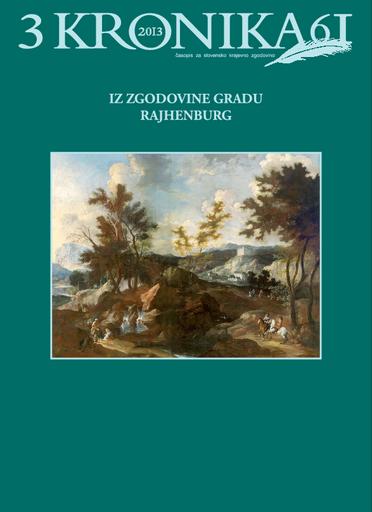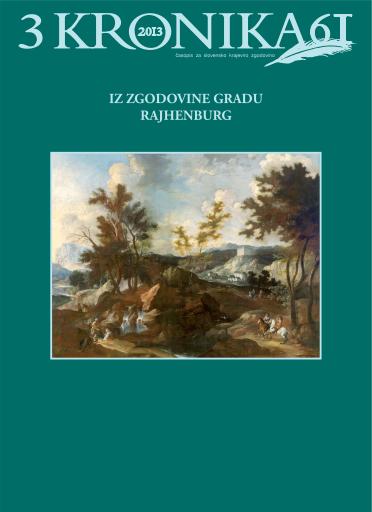/
Serijske publikacije
/
Kronika: časopis za slovensko krajevno zgodovino
Trapisti v Rajhenburgu

Avtor(ji):Irena Fürst
Soavtor(ji):Miha Preinfalk (odg. ur.), Barbara Šterbenc Svetina (teh. ur.), Alenka Cizel (prev.), Manca Gašperšič (prev.), Andreja Jankovič Deržič (prev.), Dejan Zadravec (prev.), Lidija Slana (prev.), Meta Osredkar (prev.), Agencija MultiLingual (prev.), Irena Bruckmüller Vilfan (prev.)
Leto:2013
Založnik(i):Zveza zgodovinskih društev Slovenije, Ljubljana
Vir(i):Kronika, 2013, št. 3
Jezik(i):slovenščina
Vrst(e) gradiva:besedilo
Ključne besede:Grad Rajhenburg, trapisti, samostan Marije Rešiteljice, sir trapist, čokolada Imperial, liker Trapistin, elektrarna, telefon, tiskarna, Rajhenburg Castle, Trappists, Monastery of St Mary the Saviour (Marija Rešiteljica), Trappist cheese, Imperial chocolate, Trappistine liqueur, electric power plant, telephone, printing press
Avtorske pravice:

To delo avtorja Irena Fürst je ponujeno pod Creative Commons Priznanje avtorstva-Nekomercialno-Brez predelav 4.0 Mednarodna
Datoteke (1)

Ime:kronika-2013_3.pdf
Velikost:66.73MB
Format:application/pdf
Stalna povezava:https://hdl.handle.net/11686/file18349
Opis
Menihi trapisti, ki so prišli iz Francije in leta 1881 kupili grad Rajhenburg, so zaznamovali tako zgodovino
samega gradu kot kraja in širšega območja. K nam so namreč prinesli napredek na vseh področjih dela in
gospodarskih dejavnosti. Kljub temu da so strog kontemplativni red in so v svoje življenje in delo vnesli stroga
pravila meniškega življenja sv. Benedikta, so bili na območju današnjega Posavja in v nekem smislu cele Slovenije
vir napredka in so nam pustili bogato kulturno dediščino. K nam so pripeljali prve stroje za obdelovanje zemlje,
redili plemenske sorte živali, izdelovali sir trapist, iz vina so začeli delati peneče se vino in škropili vinsko trto proti
peronospori. V različnih obrtnih delavnicah so začeli uporabljati stroje in izdelovali vse, kar se je dalo narediti
ročno. Z blagovno znamko »IMPERIAL« so bili na Slovenskem tudi prvi izdelovalci čokolade.
Metapodatki (12)
- identifikatorhttps://hdl.handle.net/11686/35000
- naslov
- Trapisti v Rajhenburgu
- Trappists in Rajhenburg
- ustvarjalec
- Irena Fürst
- soavtor
- Miha Preinfalk (odg. ur.)
- Barbara Šterbenc Svetina (teh. ur.)
- Alenka Cizel (prev.)
- Manca Gašperšič (prev.)
- Andreja Jankovič Deržič (prev.)
- Dejan Zadravec (prev.)
- Lidija Slana (prev.)
- Meta Osredkar (prev.)
- Agencija MultiLingual (prev.)
- Irena Bruckmüller Vilfan (prev.)
- predmet
- Grad Rajhenburg
- trapisti
- samostan Marije Rešiteljice
- sir trapist
- čokolada Imperial
- liker Trapistin
- elektrarna
- telefon
- tiskarna
- Rajhenburg Castle
- Trappists
- Monastery of St Mary the Saviour (Marija Rešiteljica)
- Trappist cheese
- Imperial chocolate
- Trappistine liqueur
- electric power plant
- telephone
- printing press
- opis
- Menihi trapisti, ki so prišli iz Francije in leta 1881 kupili grad Rajhenburg, so zaznamovali tako zgodovino samega gradu kot kraja in širšega območja. K nam so namreč prinesli napredek na vseh področjih dela in gospodarskih dejavnosti. Kljub temu da so strog kontemplativni red in so v svoje življenje in delo vnesli stroga pravila meniškega življenja sv. Benedikta, so bili na območju današnjega Posavja in v nekem smislu cele Slovenije vir napredka in so nam pustili bogato kulturno dediščino. K nam so pripeljali prve stroje za obdelovanje zemlje, redili plemenske sorte živali, izdelovali sir trapist, iz vina so začeli delati peneče se vino in škropili vinsko trto proti peronospori. V različnih obrtnih delavnicah so začeli uporabljati stroje in izdelovali vse, kar se je dalo narediti ročno. Z blagovno znamko »IMPERIAL« so bili na Slovenskem tudi prvi izdelovalci čokolade.
- The Trappist monks that arrived from France and bought the Rajhenburg Castle in 1881 have left a mark on the histories of both the Castle itself and the wider surrounding area. They introduced progressive practices in all fields of labour and business activity. Despite being a strict, contemplative order, following the strict rules of monastic life as practised by St Benedict, they represent a source of progress for the area of the current Lower Sava Valley (Posavje), and, to an extent, the whole of Slovenia, having left behind a rich cultural heritage. They introduced the first machines for working the land, bred the first species of breeding cattle, made Trappist cheese, produced sparkling wine from the vines of the area, and sprayed the grape vines against downy mildew. Their various workshops employed machines and produced all the products they could possibly make by hand. Under the »IMPERIAL« trademark, they were the first to produce chocolate in the Slovenian region.
- The Trappist order was established in 1664 in France, when Abbot Rance reformed the Order of Cistercians – that is why Trappists are also called Reformed Cistercians or »Order of Cistercians of Strict Observance«. In 1880, the French authorities dissolved the Notre Dame Des Dombes Monastery near Lyon. The monks from this Monastery found a new home in Castle Rajhenburg. Using brother Gabriel Giraud's money, they bought the Castle from Count Esebeck and made it into the Monastery of St Mary the Saviour. The Monastery was initially established as a Priory, and in 1891, it was elevated to the status of Abbey. The first two Abbots were French, but the third was a Slovene, Pij Novak. The Trappists are known as an extremely strict, contemplative order. They lived according to the motto ORA ET LABORA – pray and work. Their work day begun at one or two in the morning and went on for 17 more hours, consisting of prayers, work, penance, meditation and study. They spent the entire day together, like a family, but were not allowed to talk with each other. The vow of silence was one of the strictest proscriptions of the order. All of these characteristics were incarnated in the Trappists of Rajhenburg. Initially, the Monastery only housed French monks. It was not long before young Slovenian men began joining their ranks. Upon entering the order, they had to decide whether they would study to become priests or work as brothers, who were labourers. Schooling took place in the Monastery, with the monks themselves serving as teachers. After completing their studies they had to complete a two-year novitiate, a time of special tests, to prove that they were able to live in the Monastery and accept the harsh code of the order. After passing the novitiate, they made »temporary vows«, after which they had to join the army. Upon their return from military service, they began preparation to make »solemn vows«, while the vicars continued their schooling to become priests. One of the chief rules of the Trappist monks was that everything they needed in their daily lives, they had to make by themselves. They were involved in numerous sectors of industry – agriculture, livestock breeding, fruit farming, beekeeping, herbalism, horticulture and floriculture, as well as having various workshops. They began the industrial production of quality chocolate, chocolate candy and liqueurs as early as 1896. Their products were sold across all of Europe, even to the Emperor's court in Vienna. Emperor Franz Joseph presented them with an award for the quality of their products and the title of IMPERIAL, as well as the sign of the lion, both of which became the trademarks of their products. In 1896, for the purposes of powering their machines, they built an electric power plant, the first direct current power plant in the region of Lower Styria (Spodnja Štajerska). Electric cables were laid down, connecting their factory and the Castle to the power plant, and in the same year, they even acquired a telephone. They had their own printing press, and they even imported Chinese tea. During the Second World War, German troops occupied the Castle and dissolved the Monastery. 35 Trappists were exiled to the Independent State of Croatia, finding refuge in the Trappist Monastery Mary Star (Marija Zvezda) in Banja Luka. They returned after the war, but the Monastery was dissolved in 1947, the order abolished and the Castle nationalised. Some monks left for other Monasteries, even to other countries, some continued working as priests in the towns and villages around Styria (Štajerska), while others hung up their robes and returned to secular lives.
- založnik
- Zveza zgodovinskih društev Slovenije
- datum
- 2013
- tip
- besedilo
- jezik
- Slovenščina
- jeDelOd
- pravice
- licenca: ccByNcNd
